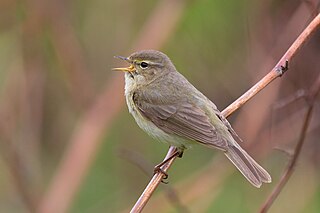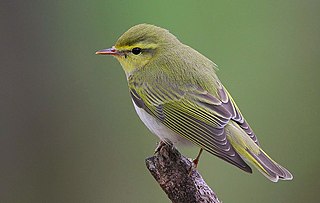
Leaf warblers are small insectivorous passerine birds belonging to the genus Phylloscopus.

The common chiffchaff, or simply the chiffchaff, is a common and widespread leaf warbler which breeds in open woodlands throughout northern and temperate Europe and the Palearctic.

The willow warbler is a very common and widespread leaf warbler which breeds throughout northern and temperate Europe and the Palearctic, from Ireland east to the Anadyr River basin in eastern Siberia. It is strongly migratory, with almost all of the population wintering in sub-Saharan Africa.

The wood warbler is a common and widespread leaf warbler which breeds throughout northern and temperate Europe, and just into the extreme west of Asian Russia in the southern Ural Mountains.

The greenish warbler is a widespread leaf warbler with a breeding range in northeastern Europe, and temperate to subtropical continental Asia. This warbler is strongly migratory and winters in India. It is not uncommon as a spring or early autumn vagrant in Western Europe and is annually seen in Great Britain. In Central Europe large numbers of vagrant birds are encountered in some years; some of these may stay to breed, as a handful of pairs does each year in Germany.

The green warbler, also known as green willow warbler or green leaf warbler, is a leaf warbler found in the Caucasus Mountains in southeastern Europe.

Pallas's leaf warbler or Pallas's warbler, is a bird that breeds in mountain forests from southern Siberia east to northern Mongolia and northeast China. It is named for German zoologist Peter Simon Pallas, who first formally described it. This leaf warbler is strongly migratory, wintering mainly in south China and adjacent areas of southeast Asia, although in recent decades increasing numbers have been found in Europe in autumn.

The yellow-browed warbler is a leaf warbler which breeds in the east Palearctic. This warbler is strongly migratory and winters mainly in tropical South Asia and South-east Asia, but also in small numbers in western Europe. Like the rest of Phylloscopidae, it was formerly included in the Old World warbler assemblage.

Hume's leaf warbler or Hume's warbler is a small leaf warbler which breeds in the mountains of inner Asia. This warbler is migratory and winters mainly in India.

Pallas's grasshopper warbler, also known as the rusty-rumped warbler, is an Old World warbler in the grass warbler genus Helopsaltes. It breeds in the eastern Palearctic: from the Altai Mountains, Mongolia and Transbaikalia to northeastern China, the Korean Peninsula, and islands in the Sea of Okhotsk. It is migratory, wintering from India eastward to Indonesia. It is a rare migrant in Sri Lanka.

The dusky warbler is a leaf warbler which breeds in the east Palearctic. The genus name Phylloscopus is from Ancient Greek phullon, "leaf", and skopos, "seeker". The specific fuscatus is from Latin fuscus "dark".

Radde's warbler is a leaf warbler which breeds in Siberia. This warbler is strongly migratory and winters in Southeast Asia. The genus name Phylloscopus is from Ancient Greek phullon, "leaf", and skopos, "seeker". The specific schwarzi commemorates German astronomer Ludwig Schwarz (1822–1894).

The Icterine warbler is an Old World warbler in the tree warbler genus Hippolais. It breeds in mainland Europe except the southwest, where it is replaced by its western counterpart, the melodious warbler. It is migratory, wintering in sub-Saharan Africa.

The western Bonelli's warbler is a warbler in the leaf warbler genus Phylloscopus. It was formerly regarded as the western subspecies of a wider "Bonelli's warbler" species, but as a result of modern taxonomic developments, they are now usually considered to be two species:

The Eastern Bonelli's warbler, sometimes known as Balkan warbler, is a "warbler" in the leaf warbler genus Phylloscopus. It was formerly regarded as the eastern subspecies of a wider "Bonelli's warbler" species, but as a result of modern taxonomic developments, they are now usually considered to be two species:

The Sakhalin leaf warbler is a species of Old World warbler in the family Phylloscopidae. It is found in Sakhalin, the Kuril Islands and Japan; it winters to the Amami and Okinawa islands.

The eastern crowned warbler is a species of Old World warbler in the family Phylloscopidae. It inhabits boreal and temperate forests in the east Palearctic.

The Oriental cuckoo or Horsfields cuckoo is a bird belonging to the genus Cuculus in the cuckoo family Cuculidae. It was formerly classified as a subspecies of the Himalayan cuckoo, with the name 'Oriental cuckoo' used for the combined species. Differences in voice and size suggest that it should be treated as a separate species. The binomial name Cuculus horsfieldi has often been used instead of Cuculus optatus, but is now usually considered to be a junior synonym.
The Kamchatka leaf warbler is a species of leaf warbler. It was formerly included in the "Old World warbler" assemblage. It is closely related to the Arctic warbler and the Japanese leaf warbler, to which it was formerly considered conspecific.

The Japanese leaf warbler is a leaf warbler. The species was first described by Robert Swinhoe in 1863. It was formerly included in the "Old World warbler" assemblage. It is closely related to the Arctic warbler and the Kamchatka leaf warbler, to which it was formerly considered conspecific.






















